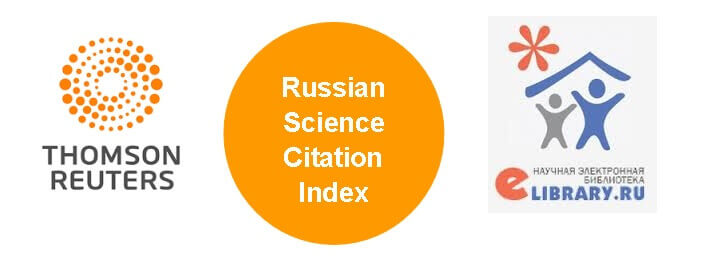Phase transformations in systems formed by titanium, silicon, aluminum, and zirconium oxides: Phase diagrams prediction and modeling. Review
Abstract
This paper provides a review of variants of phase diagrams of binary and ternary systems constituting the TiO2-Al2O3-SiO2-ZrO2 four-component system.
The study involved building spatial (three-dimensional (3D)) computer models of the isobaric phase diagrams for four ternary oxide systems (and their variants, in case of contradicting initial data obtained by different researchers) constituting this quaternary system. The geometric structure of its phase diagram was also predicted. For this purpose, phase diagram models were constructed as geometric objects in three-dimensional (3D) or four-dimensional (4D) space in the “concentration-temperature” coordinates by assembling (hyper)surfaces (unruled and ruled) and/or phase regions.
As a result:
– For the TiO2-Al2O3-SiO2 system, it was considered possible variants of the structure of liquidus surfaces. These variations were due to availability of different theories describing the formation of compounds in the TiO2-Al2O3 binary system (Al2TiO5 can melt congruently or incongruently and either possesses or does not possess the property of polymorphism).
– For the TiO2-Al2O3-ZrO2 and TiO2-SiO2-ZrO2 systems, 3D-models of phase diagrams were developed at temperatures above 1,280 and 1,400 °C, respectively. The temperature limits were due to the lack of definitive description of the structure of subsolidus regions in the TiO2-ZrO2 binary boundaring system.
– Since the main contradictions in the ZrO2-SiO2-Al2O3 system are associated with the type of phase reaction related to zircon formation (peritectic or peritectoid), the 3D model of the phase diagram was built according to the second variant, which involved the formation of the internal field of liquidus corresponding to the primary crystallization of ZrSiO4.
The structure of the phase diagrams in the subsolidus was deduced for all four systems. It was also shown that in these systems at decreasing of temperature triangulation had a place twice.
For the TiO2-Al2O3-SiO2-ZrO2 quaternary system, a scheme of phase reactions with the participation of the melt was deduced. This scheme includes six five-phase invariant reactions: two peritectic, two eutectic, and two quasi-peritectic reactions
Downloads
References
Butterman W. C., Foster W. R. Zircon stability and the ZrO2-SiO2 phase diagram. American Mineralogist. 1967;52(5-6): 880–885.
Lakiza S. M., Lopato L. M. Stable and metastable phase relations in the system alumina-zirconia-yttria. Journal of the American Ceramic Society. 1997;80(4): 893–902. https://doi.org/10.1111/j.1151-2916.1997.tb02919.x
Fedorov P. P., Yarotskaya E. G. Zirconium dioxide. Review. Condensed Matter and Interphases. 2021;23(2): 169–187. https://doi.org/10.17308/kcmf.2021.23/3427
Fischer G. R., Manfredo L. J., McNally R. N., Doman R. C. The eutectic and liquidus in the Al2O3-ZrO2 system. Journal of Materials Science. 1981;16: 3447–3451. https://doi.org/10.1007/BF00586307
Jerebtsov D. A., Mikhailov G. G., Sverdina S. V. Phase diagram of the system: Al2O3–ZrO2. Ceramics International. 2000;26: 821. https://doi.org/10.1016/S0272-8842(00)00023-7
Lakiza S., Fabrichnayay O., Wang Ch., Zinkevich M., Aldinger F. Phase diagram of the ZrO2-Gd2O3-Al2O3 system. Journal of the American Ceramic Society. 2006;26: 233–246. https://doi.org/10.1016/j.jeurceramsoc.2004.11.011
Fabrichnaya O., Aldinger F. Assessment of thermodynamic parameters in the system ZrO2-Y2O3-Al2O3. International Journal of Materials Research. 2004;95: 27–39. https://doi.org/10.3139/146.017909
Bunting E. N. Phase equilibria in the systems TiO2, TiO2-SiO2 and TiO2-Al2O3. Bureau of Standards Journal of Research. 1933;11: 719–725. https://doi.org/10.6028/jres.011.049
Toropov N. A., Barzakovskii V. P., Lapin V. V., Kurtseva N. N. State diagrams of silicate systems. The handbook. Part 1: binary systems*. Leningrad: Nauka Publ.; 1969. 822 p. (In Russ.)
Umezu S., Kakiuchi F. Investigations on iron blast. Furnace slags containing titanium. Nippon Kogyo Kwaishi. 1930;46: 866–877.
DeVries R. C., Roy R., Osborn E. F. The system TiO2-SiO2. Transactions of the British Ceramic Society. 1954;53 (9): 525–540.
Morey G. W. Data of geochemistry. Chapter L. Phase-equilibrium relations of the common rock-forming oxides except water. Washington: United States Government Printing Office; 1964. 146 p. https://doi.org/10.3133/pp440l
McTaggart G. D., Andrews A. I. Immiscibility area in the system TiO2-ZrO2-SiO2. Journal of the American Ceramic Society. 1957;40(5): 167–170. https://doi.org/10.1111/j.1151-2916.1957.tb12596.x
Galakhov F. Ya., Areshev M. P., Vavilonova V. T., Aver’yanov V. I. Determination of the boundaries of metastable liquation in the silica part of the TiO2-SiO2 system*. Izvestiia Akademii nauk SSSR: Neorganicheskie materialy. 1974;10(1): 179–180. (In Russ.)
Kamaev D. N., Archugov S. A., Mikhailov G. G. Experimental study and thermodynamic modeling of the TiO2-SiO2 system*. In: Computer modeling of the physicochemical properties of glasses and melts: Proc. VIII Rus. seminar, 16–19 October 2006. Kurgan: Kurgan State University; 2006. p. 35–36. (In Russ.)
DeCapitani C., Kirschen M. A Generalized multicomponent excess function with application to immiscible liquids in the system CaO-SiO2-TiO2. Geochimica et Cosmochimica Acta. 1998;62 (23/24): 3753–3763. https://doi.org/10.1016/S0016-7037(98)00319-6
Kirschen M., DeCapitani C., Millot F., Rifflet J.-C., Coutures J.-P. Immiscible silicate liquids in the system SiO2-TiO2-Al2O3. European Journal of Mineralogy. 1999;11(3): 427–440. https://doi.org/10.1127/ejm/11/3/0427
Kirillova S. A., Almjashev V. I., Gusarov V. V. Spinodal decomposition in the SiO2-TiO2 system and hierarchically organized nanostructures formation. Nanosystems: Physics, Chemistry, Mathematics. 2012;3(2): 100–115. (In Russ.). Available at: https://nanojournal.ifmo.ru/files/volume7/10Almjashev.pdf
Kirillova S. A., Almjashev V. I., Gusarov V. V. Phase Relationships in the SiO2-TiO2 System. Russian Journal of Inorganic Chemystry. 2011;56 (9): 1464–1471. 10.1134/S0036023611090117.
Boulay E., Nakano J., Turner S., Idrissi H., Schryvers D., Godet S. Critical assessments and thermodynamic modeling of BaO-SiO2 and SiO2-TiO2 systems and their extensions into liquid immiscibility in the BaO-SiO2-TiO2 system. CALPHAD. 2014;47: 68–82. https://doi.org/10.1016/j.calphad.2014.06.004
Ilatovskaia M., Fabrichnaya O. Liquid immiscibility and thermodynamic assessment of the Al2O3-TiO2-SiO2 system. Journal of Phase Equilibria and Diffusion. 2022;43: 15–31. https://doi.org/10.1007/s11669-021-00935-4
Geller R. F., Lang S. M. System SiO2-ZrO2. Journal of the American Ceramic Society. 1949;32: 157–159.
Toropov N. A., Galakhov F. Ya. Liquation in ZrO2-SiO2 system. Bulletin of the Academy of Sciences of the USSR. 1956;(2): 153–162. https://doi.org/10.1007/BF01177636
Berezhnoi A. S. Multicomponent systems of oxides. Kiev: Naukova Dumka Pulb.; 1970. 542 p. (In Russ.)
Kwon S. Y., Jung I.-H. Critical evaluation and thermodynamic optimization of the CaO-ZrO2 and SiO2-ZrO2 systems. Journal of the European Ceramic Society. 2017;37(3): 1105–1116. https://doi.org/10.1016/j.jeurceramsoc. 2016.10.008
Kamaev D. N., Archugov S. A., Mikhailov G. G. Study and thermodynamic analysis of the ZrO2-SiO2 system. Russian Journal of Applied Chemistry. 2005;78: 200–203. https://doi.org/10.1007/s11167-005-0259-2
Björkvall J., Stolyarova V. L. A mass spectrometric study of Al2O3-SiO2 melts using a Knudsen cell. Rapid Communications in Mass Spectrometry. 2001;15: 836–842. https://doi.org/10.1002/rcm.251
Bowen N. L., Greig J. W. The system Al2O3-SiO2. Journal of the American Ceramic Society. 1924;7(4): 238–254. https://doi.org/10.1111/j.1151-2916.1924.tb18190.x
Toropov N. A., Galakhov F. Ya. Solid solutions in the Al2O3-SiO2 system. Bulletin of the Academy of Sciences of the USSR Division of Chemical Science. 1958;7(1): 5–9. https://doi.org/10.1007/BF01170853
Aramaki S., Roy R. Phase diagram for the system Al2O3-SiO2. Journal of the American Ceramic Society. 1962;45(5): 229–242. https://doi.org/10.1111/j.1151-2916. 1962.tb11133.x
Levin E. M., Robbins C. R., McMurdie H. F. Phase diagrams for ceramists. Ohio: American Ceramic Society; 1964. 600 p.
Atlas of slags*. Ref. book: trans. with him. I. S. Kulikova (ed.). Moscow: Metallurgy Publ.; 1985. 208 p. (In Russ.)
Strelov K. K., Kashcheev I. D. Phase diagram of the system Al2O3-SiO2. Refractories. 1995;36 (7-8): 244–246. https://doi.org/10.1007/BF02227394
Fabrichnaya O., Costa e Silva A., Aldinger F. Assessment of thermodynamic functions in the MgO-Al2O3-SiO2 system. International Journal of Materials Research. 2004;95(9): 793–805. https://doi.org/10.3139/146.017909
de Noirfontaine M. N., Tusseau-Nenez S., Girod-Labianca C., Pontikis V. CALPHAD formalism for Portland clinker: thermodynamic models and databases. The Journal of Materials Science. 2012;47: 1471–1479. https://doi.org/10.1007/s10853-011-5932-7
Shepherd E. S., Rankin G. A., Wright F. E. The binary systems of alumina with silica, lime and magnesia. American Journal of Science. 1909;(28): 293–333. Available at: https://zenodo.org/records/1633772
Klug F. J., Prochazka S. Alumina-silica phase diagram in the mullite region. Journal of the American Ceramic Society. 1987;70(10): 750–759. https://doi.org/10.1111/j.1151-2916. 1987.tb04875.x
Aksay I. A., Pask J. A. Stable and metastable equilibria in the system SiO2-Al2O3. Journal of the American Ceramic Society. 1975;58(10-14): 507–512. https://doi.org/10.1111/j.1151-2916.1975.tb18770.x
Shornikov S. I., Archakov I. Yu., Chemekova T. U. A mass spectrometry study of evaporation processes and phase equilibria in the Al2O3-SiO2 system. Russian Journal of Physical Chemistry A. 2000;74(5): 684–688. Available at: https://elibrary.ru/item.asp?id=13347337
Eriksson G., Pelton A. D. Critical evaluation and optimization of the thermodynamic properties and phase diagrams of the CaO-Al2O3, Al2O3-SiO2, and CaO-Al2O3-SiO2 systems. Metallurgical Transactions B. 1993;24B: 807–816. https://doi.org/10.1007/BF02663141
Mao H., Selleby M., Sundman B. Phase equilibria and thermodynamics in the Al2O3-SiO2 system - modeling of mullite and liquid. Journal of the American Ceramic Society. 2005;88(9): 2544–2551. https://doi.org/10.1111/j.1551-2916.2005.00440.x.
Yazhenskikh E., Hack K., Müller M. Critical thermodynamic evaluation of oxide systems relevant to fuel ashes and slags. Part 3: silica-alumina system. CALPHAD. 2008;32: 195–205. https://doi.org/10.1016/j.calphad.2007.05.004
Ban T., Hayashi S., Yasumori A., Okada K. Calculation of metastable immiscibility region in the Al2O3-SiO2 system. Journal of Materials Research. 1996;11 (6): 1421-1427. https://doi.org/10.1557/jmr.1996.0178
Björkvall J., Stolyarova V. L. A mass spectrometric study of Al2O3-SiO2 melts using a Knudsen cell. Rapid Communications in Mass Spectrometry. 2001;15(10): 836–842. https://doi.org/10.1002/rcm.251
Kwon S. Y., Jung I.-H. Thermodynamic assessment of the Al2O3-ZrO2, CaO-Al2O3-ZrO2, and Al2O3-SiO2-ZrO2 system. Ceramics International. 2022;48: 5413–5427. https://doi.org/10.1016/j.ceramint.2021.11.085
Lambotte G., Chartrand P. Thermodynamic evaluation and optimization of the Al2O3–SiO2-AlF3-SiF4 reciprocal system using the modified quasichemical model. Journal of the American Ceramic Society. 2011;94: 4000–4008. https://doi.org/10.1111/j.1551-2916.2011.04656.x
Igami Y., Ohi S., Miyake A. Sillimanite-mullite transformation observed in synchrotron X-ray diffraction experiments. Journal of the American Ceramic Society. 2017;100: 4928–4937. https://doi.org/10.1111/jace.15020
Yarotskaya E. G., Fedorov P. P. Mullite and its isomorphic substitution. Condensed Matter and Interphases. 2018;20(4): 537–544. https://doi.org/10.17308/kcmf.2018.20/626
Saenko I., Ilatovskaia M., Savinykh G., Fabrichnaya O. Experimental investigation of phase relations and thermodynamic properties in the ZrO2-TiO2 system. Journal of the American Ceramic Society. 2018;101: 386–399. https://doi.org/10.1111/jace.15176
Troitzsch U., Ellis D. J. The ZrO2-TiO2 phase diagram. Journal of Materials Research. 2005;40(11): 4571–4577. https://doi.org/10.1007/s10853-005-1116-7
Ilatovskaia M., Savinykh G., Fabrichnaya O. Thermodynamic description of the Ti-Al-O system based on experimental data. Journal of Phase Equilibria and Diffusion. 2017;38 (3): 175–184. https://doi.org/10.1007/s11669-016-0509-4
Lang S., Fillmore C., Maxwell L. The system beryllia-alumina-titania: phase relations and general physical properties of three-component porcelains. Journal of Research of the National Bureau of Standards. 1952;48: 301–321. Available at: https://doi.org/10.6028/jres.048.038
Freudenberg B. Etude de la reaction à l’état solide: Al2O3+TiO2-Al2TiO5. Tesis Doctoral. Eĉole Polytécnique, Lausanne. 1987. 262 p. https://doi.org/10.5075/epfl-thesis-709
de Arenas I. B. Reactive sintering of aluminum titanate. In: Sintering of Ceramics-New Emerging Techniques. Arunachalam Lakshmanan (ed.). InTech; 2012. p. 501–526. https://doi.org/10.5772/34366
Norberg S. T., Hoffmann S., Yoshimura M., Ishizawa N. Al6Ti2O13, a new phase in the Al2O3-TiO2 system. Acta Crystallographica. Section C. 2005;C61: i35-i38. https://doi.org/10.1107/s0108270105002532
Hoffmann S., Vasylechko L. O., Trots D. M., Yoshimura M. Thermal expansion of Al6Ti2O13 between 20 K and 1173 K. Zeitschrift für anorganische und allgemeine Chemie. 2010;636: 2059–2059. https://doi.org/10.1002/zaac.201009020
Hoffmann S., Norberg S. T., Yoshimura M. Melt synthesis of Al2TiO5 containing composites and reinvestigation of the phase diagram Al2O3-TiO2 by powder X-ray diffraction. Journal of Electroceramics. 2006;16: 327–330. https://doi.org/10.1007/s10832-006-9873-5
Berger M. H., Sayir A. Directional solidification of the Al2O3-Al2TiO5 system. Journal of the European Ceramic Society. 2008;28: 2411–2419. https://doi.org/10.1016/j.jeurceramsoc.2008.03.005
Jung I.-H., Eriksson G., Wu P., Pelton A. Thermodynamic modeling of the Al2O3-Ti2O3-TiO2 system and its applications to the Fe-Al-Ti-O inclusion diagram. ISIJ International. 2009;49: 1290–1297. https://doi.org/10.2355/isijinternational.49.1290
Panda S. K., Jung I.-H. Coupled experimental study and thermodynamic modeling of the Al2O3-Ti2O3-TiO2 system. ISIJ International. 2020:60: 31–41. https://doi.org/10.2355/isijinternational.ISIJINT-2019-006
Azimov S. A., Gulamova D. D. Mel’nik N. N., Sarkisova M. Kh., Suleimanov S. Kh., Tsapenko L. M. An investigation of aluminum titanate produced in the solar furnace*. Izvestiya Akademii Nauk SSSR. Inorganic Matererials. 1984;20(3): 469–471. (In Russ.)
Guljamova D. D., Sarkisova M. H. Interaction of aluminium and titanium oxides at high temperatures*. Doklady Akademii Nauk SSSR. Inorganic Materials. 1989;25(5): 789–794. (In Russ.)
Stolyarova V. L., Vorozhtcov V. A., Shemchuk D. V., Lopatin S. I., Bogdanov O. A. High temperature mass spectrometry study of the TiO2-Al2O3 system. Russian Journal of General Chemistry. 2021;91(10): 1999–2007. https://doi.org/10.1134/S107036322110011X
Agamawi Y. M., White J. The system Al2O3-TiO2-SiO2. Transactions of the British Ceramic Society. 1952;51(5): 293–325.
Toropov N. A., Barzakovsky V. P., Lapshin V. V., Kurtseva N. N., Boikova A. I. State diagrams of silicate systems. Reference book. Issue 3. Ternary silicate systems*. Leningrad, Nauka Publ.; 1972. 448 p. (In Russ.)
Galakhov F. Ya. The study of the alumina-rich area of aluminosilicate systems. Report 3. The TiO2-Al2O3-SiO2 system*. Izvestiia Akademii Nauk SSSR. Seriia Khimicheskaia. 1958;(5): 529–534. (In Russ.).
Fidancevska E., Vassilev V. Obtaining of powders by controlled hydrolysis and sintering of materials from the TiO2-Al2O3-SiO2 system. Journal of Chemical Technology and Metallurgy. 2010;45(4): 421–430. Available at: https://journal.uctm.edu/node/j2010-4/10_Venci_Vassilev_425-434.pdf
Ilatovskaia M., Bärtel F., Fabrichnaya O. Phase relations in the Al2O3-TiO2-SiO2 system. Ceramics International. 2020;46(18): Part B: 29402–29412. https://doi.org/10.1016/j.ceramint.2020.05.103
Budnikov P. P., Litvakovsky A. A. To study the Al2O3-SiO2-ZrO2 system*. Bulletin of the Russian Academy of Sciences USSR. 1956;106(2): 267. (In Russ.)
Greca M. C., Emiliano J. V., Segadães A. M. Revised phase equilibrium relationships in the system Al2O3-ZrO2-SiO2. Journal of the European Ceramic Society. 1992;9(4): 271–283. https://doi.org/10.1016/0955-2219(92)90062-I
Ferrari C. R., Rodrigues J. A. Microstructural features of alumina refractories with mullite-zirconia aggregates. Boletín de la Sociedad Española de Cerámica y Vidrio. 2003;42: 15–20. https://doi.org/10.3989/cyv.2003.v42.i1.651
Quereshi M. H., Brett N. H. Phase equilibria in ternary systems containing zirconia and silica. II. The system A12O3-ZrO2-SiO2. Transactions of the British Ceramic Society. 1968;67(11): 569–579.
Pena P., De Aza S. The zircon thermal behavior: effect of impurities. Journal of Materials Science. 1984;19: 135–142. https://doi.org/10.1007/bf02403119
Pena P. Refractarios para zonas de contacto con el vidrio. Boletín de la Sociedad Española de Cerámica y Vidrio. 1989;28: 89–96. Available at: https://boletines.secv.es/upload/198928089.pdf
Sánchez Soto P. J., Pérez Rodríguez J. L. Características generales, propiedades, yacimientos y aplicaciones de pirofilita. II. Yacimientos, aplicaciones y utilización como materia prima cerámica. Boletín de la Sociedad Española de Cerámica y Vidrio. 1998;37: 359–368. https://doi.org/10.3989/cyv.1998.v37.i5.995
Vorob’eva V. P., Zelenaya A. E., Lutsyk V. I. Using a 3D computer model of the T-x-y diagram of the ZrO2-SiO2-Al2O3 system to resolve contradictions in the initial experimental data. Russian Journal of Inorganic Chemystry. 2021;66(6): 894–901. https://doi.org/10.1134/S003602362106022X
Ilatovskaia M., Savinykh G., Fabrichnaya O. Thermodynamic description of the ZrO2-TiO2-Al2O3 system based on experimental data. Journal of the European Ceramic Society. 2017;37(10): 3461–3469. https://doi.org/10.1016/j.jeurceramsoc.2017.03.064
Barzakovskii V. P., Lapin, V. V., Bojkova A. I., Kurtseva N. N. State diagrams of silicate systems. The Handbook. Part 4: Ternary silicate systems*. Leningrad: Nauka Publ.; 1974. 514 p. (In Russ.).
Coughanour L. W., Roth R. S., De Prosse V. A. Phase equilibrium relations in the system lime-titania and zirconia-titania. Journal of Research of the National Bureau of Standards. 1954;52(1): 37–42. Available at: https://nvlpubs.nist.gov/nistpubs/jres/52/jresv52n1p37_A1b.pdf
Shevchenko A. V., Lopato L. M., Meister I. M., Gorbunov O. S. ZrO2-TiO2 system*. Russian Journal of Inorganic Chemystry. 1980;25(9): 2496–2499. (In Russ.)
Pena P., De Aza S. El sistema ZrO2-SiO2-TiO2. Boletín de la Sociedad Española de Cerámica y Vidrio. 1976;15(2): 93–95.
Belov G. V., Aristova N. M. Databases on the properties of materials and substances for nuclear power*. Mathematical Models and Computer Simulations. 2017;29(6): 135–142. Available at: http://mi.mathnet.ru/eng/mm/v29/i6/p135 (In Russ.)
Ohnuma I., Ishida K. Phase diagrams as tools for advanced materials design: applications to non-ferrous alloys. Tecnologia em Metalurgia, Materiais e Mineração. 2016;13(1): 46. http://dx.doi.org/10.4322/2176-1523.1085
Bakardjieva S., Barrachin M., Bechta S., … Wiss T. Quality improvements of thermodynamic data applied to corium interactions for severe accident modelling in SARNET2. Annals of Nuclear Energy. 2014;74: 110–124. https://doi.org/10.1016/j.anucene.2014.06.023
Kitagaki T., Yano K., Ogino H., Washiya T. Thermodynamic evaluation of the solidification phase of molten core-concrete under estimated Fukushima daiichi nuclear power plant accident conditions. Journal of Nuclear Materials. 2017;486: 206–215. https://doi.org/10.1016/j.jnucmat.2017.01.032
Bakardjieva S., Barrachin M., Bechta S., … Wiss T. Improvement of the european thermodynamic database NUCLEA. Progress in Nuclear Energy. 2010;52: 84–96. https://doi.org/10.1016/j.pnucene.2009.09.014
Kwon S. Y. Thermodynamic optimization of ZrO2-containing systems in the CaO-MgO-SiO2-Al2O3-ZrO2 system. Dissertation. Department of mining and materials engineering. McGill University. Montreal, QC. 2015. 113 p. Available at: https://escholarship.mcgill.ca/concern/theses/dz010t00f
Lutsyk V. I., Vorob’eva V. P. Computer models of eutectic-type T-x-y diagrams with allotropy. Two inner liquidus fields of two low-temperature modifications of the same component. Journal of Thermal Analysis and Calorimetry. 2010;101(1): 25–31. https://doi.org/10.1007/s10973-010-0855-0
Lutsyk V. I., Vorob’eva V. P. 3D Model of the T–x–y Diagram of the Bi-In-Sn System for designing microstructure of alloys. Russian Journal of Inorganic Chemystry. 2016;61(2): 188–207. https://doi.org/10.1134/S0036023616020121
Vorob’eva V. P., Zelenaya A. E., Lutsyk V. I., Sineva S. I., Starykh R. V., Novozhilova O. S. High-Temperature area of the Fe-Ni-Co-Cu diagram: experimental study and computer design. Journal of Phase Equilibria and Diffusion. 2021;42(2): 175–193. https://doi.org/10.1007/s11669-021-00863-3
Lutsyk I. V., Zelenaya A. E., Zyryanov A. M. Multicomponent systems simulation by the software of “Diagrams Designer”. Journal of International Scientific Publications: Materials, Methods and Technologies. 2008;2(1): 176–184. Available at: https://www.scientific-publications.net/download/materials-methods-and-technologies-2008.pdf
Lutsyk V. I., Vorob’eva V. P. Three-dimensional model of phase diagram of Au-Bi-Sb system for clarification of thermodynamic calculations. Russian Journal of Physical Chemistry. 2015;89(10): 1715–1722. https://doi.org/10.1134/S0036024415100192
Lutsyk V. I., Vorob’eva V. P., Shodorova S. Ya. Verification of the T–x–y diagram of the Ag–Au–Bi system using a 3D computer model. Russian Journal of Inorganic Chemystry. 2016;61(7): 858–866. https://doi.org/10.1134/S0036023616070123
Nasrulin E. R., Lutsyk V. I., Vorobyova V. P. Visualization of crystallization paths and calculation of material balance in ternary phase diagrams*. Copyright certificate of RF No. 50200601390; ESPD.03524577.01520-01; No. 6632; application 06/29/2006; Publ. 08.08.2006 (In Russ.)
Lutsyk V. I., Vorob’eva V. P., Zelenaya A. E. 3D reference book on the oxide systems space diagrams as a tool for data mining. Solid State Phenomena. 2015;230: 51–54. https://doi.org/10.4028/www.scientific.net/ssp.230.51
Vorob’eva V. P., Zelenaya A. E., Lutsyk V. I. Analysis of the geometric features of T-x-y diagrams with melt immiscibility for silicate systems. Journal of Physics: Conference Series. 2021;1791(1): 012121. https://doi.org/10.1088/1742-6596/1791/1/012121
Vorob’eva V. P., Zelenaya A. E., Lutsyk V. I., Lamueva M. V. A 3D computer model of the CaO-MgO-Al2O3 T-x-y diagram at temperatures above 1300 °C. Condensed Matter and Interphases. 2021;23(3): 380–386. https://doi.org/10.17308/kcmf.2021.23/3529
Lutsyk V. I., Zelenaya A. E., Savinov V. V. Phase trajectories in CaO-Al2O3-SiO2 melts. Crystallography Reports. 2012;57(7): 943–947. https://doi.org/10.1134/s1063774512070176
Lutsyk V., Zelenaya A. Crystallization paths in SiO2-Al2O3-CaO system as a genotype of silicate materials. IOP Conference Series: Materials Science and Engineering. 2013;47: 012047. https://doi.org/10.1088/1757-899x/47/1/012047
Lutsyk I. V., Zelenaya A. E., Nasrulin E. R., Zyryanov A. M. The NaCl-CaCl2-MgCl2 system: analysis of zero-, one- and two-dimensional concentration fields. Melts. 2016;(3): 216–225. Available at: https://www.elibrary.ru/item.asp?id=27184380 (In Russ.)
Lutsyk V. I., Zelenaya A. E. Т-х-у diagram of the MgO-SiO2-Al2O3 system: microstructure design. Russian Journal of Inorganic Chemistry. 2018;63(8): 1087–1091. https://doi.org/10.1134/S0036023618080132
Connell R. G. A tutorial on flow diagrams: a tool for developing the structure of multicomponent phase diagrams. Journal of Phase Equilibria and Diffusion. 1994;15(1): 6–19. https://doi.org/10.1007/BF02667677
Vorozhtcov V. A., Yurchenko D. A., Almjashev V. I., Stolyarova V. L. Phase equilibria in the Al2O3-SiO2-ZrO2 system: calculation and experiment. Glass Physics and Chemistry. 2021;47: 417–426. https://doi.org/10.1134/S1087659621050175
Vorob’eva V. P., Zelenaya A. E., Lutsyk V. I., Vorozhtcov V. A., Almjashev V. I., Stolyarova V. L. State diagram of the ZrO2-SiO2-Al2O3 system with visualization by 3D computer model and calculation using the NUCLEA database. Doklady Physical Chemistry. 2023;511(1): 107–116. https://doi.org/10.1134/S0012501623600079
Vorob’eva V. P., Zelenaya A. E., Lutsyk V. I., Vorozhtcov V. A., Almjashev V. I., Sokolova T. V., Stolyarova V. L. Modeling of the ZrO2-SiO2-Al2O3 phase diagram using simulation by the 3D computer model and the NUCLEA database. Materials Science and Engineering B. 2023;297: 116790. https://doi.org/10.1016/j.mseb.2023.116790
Lutsyk V., Zelenaya A., Zyryanov A., Nasrulin E. Computer models of phase diagrams for ceramic systems. TiO2-SiO2-Al2O3 and ZrO2-SiO2-Al2O3. Epitoanyag - Journal of Silicate Based and Composite Materials. 2016;68(2): 52–55. https://doi.org/10.14382/epitoanyag-jsbcm.2016.9
Vorob’eva V. P., Zelenaya A. E., Lutsyk V. I., Almjashev V. I., Vorozhtcov V. A., Stolyarova V. L. Prediction of the liquidus of the quaternary system of titanium, aluminim, silicon, and zirconium oxides. Glass Physics and Chemistry. 2021;47(6): 616–621. https://doi.org/10.1134/S1087659621060328
Copyright (c) 2024 Kondensirovannye sredy i mezhfaznye granitsy = Condensed Matter and Interphases

This work is licensed under a Creative Commons Attribution 4.0 International License.













